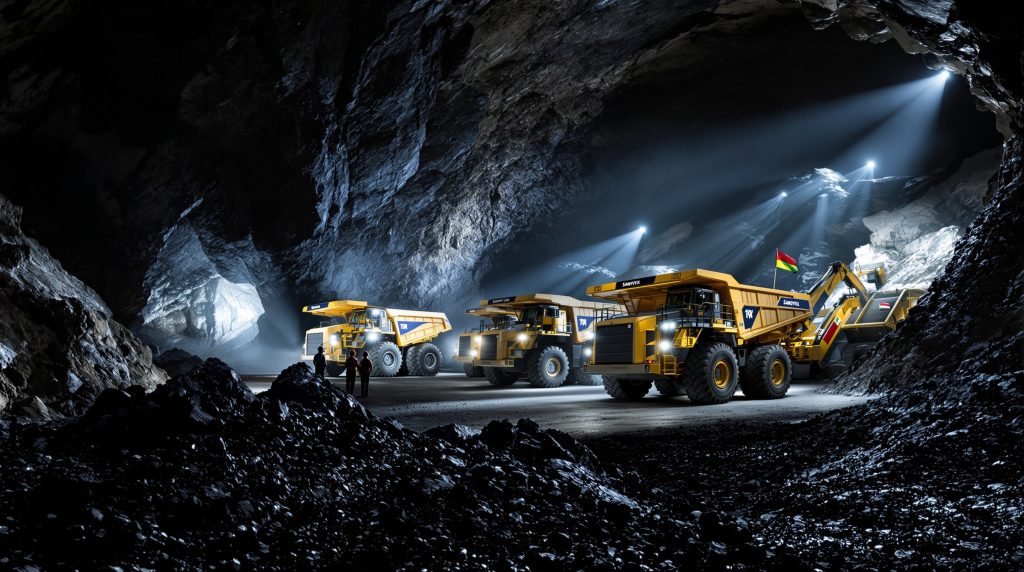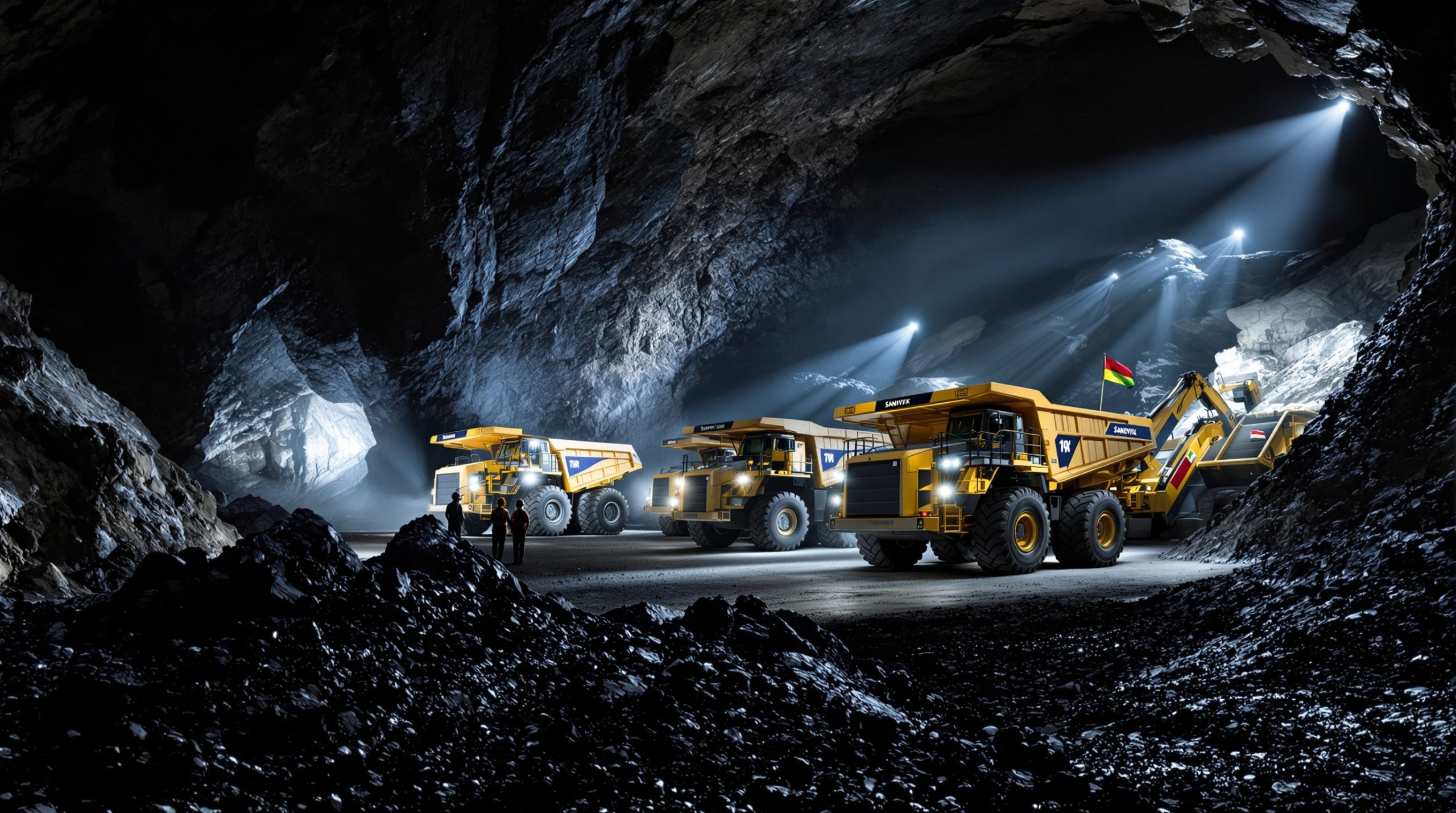What Makes Sandvik's Zimbabwe Mining Equipment Deal Significant?
The recent US$30 million underground mining equipment order secured by Sandvik from Zimplats represents a landmark development in Zimbabwe's mining sector. This substantial investment demonstrates growing confidence in the country's mining industry while highlighting the strategic importance of modern mine planning at Africa's platinum mining operations. Zimplats, the largest platinum group metals producer in Zimbabwe, has committed to a significant technological upgrade with this comprehensive equipment package for the Ngezi complex.
The Scale and Scope of the Equipment Order
The magnitude of this investment becomes clear when examining the specific components included in the 28-piece specialized underground mining equipment order:
- Six Sandvik DD211L development jumbos
- Twelve Toro LH209L loaders
- Five Sandvik DS211L-V bolters
- Three Toro TH545i trucks
- Two Sandvik TH430L trucks
This comprehensive order also includes parts and service kits, ensuring operational continuity and maintenance capability. The equipment selection reflects a strategic approach to modernizing underground mining operations with a focus on productivity, safety, and efficiency.
Timeline and Implementation Strategy
The investment follows a carefully planned schedule:
- Order booked in Q3 2025
- Phased delivery from Q3 2025 through Q2 2026
- Strategic deployment to minimize operational disruption
- Integration with existing infrastructure at the Ngezi complex
This phased approach demonstrates thoughtful planning to ensure smooth integration of new technologies without compromising ongoing production activities.
How Will This Equipment Transform Zimbabwe's Mining Operations?
Modernizing Underground Mining at Ngezi
This equipment acquisition marks a significant shift in Zimplats' operational approach, transitioning from conventional mining methods to more advanced underground techniques. This transformation aims to revolutionize several aspects of mining operations:
- Increased extraction efficiency in deep platinum deposits through precision drilling and loading
- Extended mine life through access to previously unreachable reserves
- Reduced operational costs through automation and digital solutions
- Minimized environmental footprint compared to traditional mining approaches
The introduction of cutting-edge equipment addresses the growing complexities of accessing platinum group metals in Zimbabwe's Great Dyke geological formation, where surface deposits are increasingly depleted and underground operations become essential.
Safety and Productivity Enhancements
The new Sandvik mining equipment order Zimbabwe introduces advanced safety features specifically designed for underground mining environments:
- Improved operator protection systems including enhanced cabins and emergency features
- Advanced ventilation management capabilities
- Reduced manual handling requirements that minimize worker exposure to hazards
- Increased mechanization of high-risk activities
- Real-time monitoring capabilities for early hazard detection
These safety enhancements align with global mining trends evolution toward zero-harm workplaces while simultaneously boosting productivity through more efficient operations.
What Are the Economic Implications for Zimbabwe's Mining Sector?
Strengthening Zimbabwe's Position in Global Platinum Production
This substantial investment reinforces Zimbabwe's standing in the global platinum group metals (PGM) market:
- Zimplats maintains its position as Zimbabwe's largest PGM producer
- Increased production capacity strengthens export potential and foreign exchange earnings
- Enhanced operational efficiency improves competitive position against other major producers
- Technological advancement attracts additional investment interest in Zimbabwe's mining sector
The timing of this investment is particularly significant as global demand for platinum group metals continues to grow, driven by automotive catalytic converters, electronics, and emerging hydrogen technologies.
Impact on Local Economy and Employment
The equipment acquisition creates cascading economic benefits throughout Zimbabwe's economy:
- Skills development opportunities for the local workforce through technical training
- Knowledge transfer through specialized training programs for operators and maintenance personnel
- Indirect employment through service and support industries
- Increased tax revenue from expanded mining operations
Mining sector investments of this magnitude typically generate a multiplier effect throughout the regional economy, supporting ancillary businesses and community development initiatives.
How Does This Deal Reflect Regional Mining Trends?
Strategic Focus on African Mining Markets
Sandvik's major equipment order demonstrates the growing importance of African mining operations in global supplier strategies:
- Increased manufacturer focus on emerging African economies as mining growth regions
- Recognition of Zimbabwe's mineral wealth potential despite historical challenges
- Adaptation of equipment designs for specific regional mining conditions
- Development of regional service and support infrastructure
This investment reflects a broader trend of mining equipment manufacturers developing specialized solutions for African mining conditions, acknowledging the continent's growing importance in global mineral supply chains.
Comparison with Similar Regional Mining Investments
Recent major mining equipment investments across southern Africa demonstrate a regional trend toward modernization:
| Country | Recent Major Equipment Orders | Value (USD) | Mining Focus |
|---|---|---|---|
| Zimbabwe (Zimplats) | 28 pieces of underground equipment | ~$30 million | Platinum group metals |
| Botswana | Similar Sandvik underground fleet | Comparable | Diamond mining |
| South Africa | Multiple equipment modernization programs | $50-100 million | Gold and platinum |
| Zambia | Copper mine expansion equipment | $45 million | Copper |
These investments collectively signal confidence in the region's mining sector despite various political and economic challenges faced by individual countries.
What Technologies Are Being Deployed?
Digital Innovation and Automation Solutions
The equipment package incorporates Sandvik's latest technological advancements:
- Automated drilling and loading systems that increase precision and efficiency
- Digital fleet management capabilities for real-time monitoring and optimization
- Remote monitoring and diagnostic tools that reduce downtime
- Predictive maintenance technologies that identify potential issues before failure
- Equipment performance optimization systems that maximize productivity
These technologies represent the cutting edge of mining equipment innovation, bringing Industry 4.0 principles to Zimbabwe's mining sector through data-driven operations.
Energy Efficiency and Sustainability Features
In response to Zimbabwe's energy challenges, the equipment includes:
- Reduced fuel consumption designs that lower operational costs
- Optimized engine performance for underground conditions
- Improved emissions control systems that enhance air quality
- Energy recovery technologies that reduce overall power requirements
- Extended service intervals reducing maintenance resource requirements
These features address both environmental concerns and practical operational challenges in a region where energy reliability remains a significant issue for industrial operations.
What Does This Mean for Zimplats' Future Operations?
Supporting Underground Expansion Strategy
The equipment acquisition aligns with Zimplats' long-term development vision:
- Transition from open-pit to underground mining methods as surface resources deplete
- Accessing deeper, more complex ore bodies within the Great Dyke formation
- Extending operational lifespan of existing mining areas
- Reducing surface disturbance through underground focus
- Optimizing resource extraction from platinum-rich geological formations
This strategic pivot ensures Zimplats' continued viability as a premier platinum producer while adapting to changing geological realities.
Long-Term Performance and Operational Excellence
The comprehensive equipment package includes elements designed to ensure sustained performance:
- Ongoing service support agreements that guarantee equipment availability
- Parts supply arrangements that minimize downtime
- Technical training programs for local operators and maintenance staff
- Performance optimization consulting to maximize equipment effectiveness
- Regular equipment upgrades and updates to incorporate technological advances
These support structures demonstrate a long-term commitment to operational excellence rather than a one-time equipment purchase.
How Does This Investment Compare to Global Mining Equipment Trends?
Global Mining Equipment Market Context
Sandvik's Zimbabwe order reflects broader industry developments:
- Growing preference for integrated equipment solutions rather than individual machines
- Increasing focus on automation and digital technologies to overcome skill shortages
- Rising importance of energy efficiency in equipment selection decisions
- Greater emphasis on equipment lifespan and total cost of ownership
- Shift toward more sustainable mining practices globally
These trends are reshaping mining operations worldwide as operators seek to balance productivity, sustainability, and profitability.
Equipment Selection Factors for Modern Mining Operations
The Zimplats order highlights key considerations in contemporary mining equipment procurement:
- Productivity and efficiency improvements that deliver measurable returns
- Safety enhancement capabilities that protect workers in hazardous environments
- Environmental impact reduction technologies that address regulatory requirements
- Energy consumption optimization to control operating costs
- Total lifecycle cost management beyond initial purchase price
- Operator comfort and usability features that improve workforce retention
- Maintenance requirements and serviceability considerations
These selection criteria reflect the complex, multi-faceted decision-making process in modern mining equipment procurement.
What Challenges Must Be Addressed for Successful Implementation?
Infrastructure and Operational Considerations
Successful deployment of the new equipment will require addressing several infrastructure challenges:
- Adequate power supply infrastructure to support advanced equipment
- Specialized maintenance facilities for high-tech components
- Trained technical personnel capable of operating digital systems
- Optimized underground mine design to accommodate new equipment
- Effective change management processes to transition from existing methods
These foundational elements must be in place to realize the full potential of the equipment investment.
Training and Workforce Development Needs
The technological advancement represented by the new equipment necessitates comprehensive skill development:
- Operator training programs for complex digital interfaces
- Technical maintenance skill development beyond traditional mechanical knowledge
- Digital systems management capabilities for data analysis and optimization
- Safety protocol updates and training for new equipment types
- Knowledge transfer from equipment suppliers to local workforce
This workforce development component represents a significant but often underestimated aspect of mining modernization.
What Are the Broader Implications for Zimbabwe's Mining Future?
Setting New Standards for Mining Operations
This significant investment establishes benchmarks for the wider Zimbabwean mining sector:
- Demonstration of advanced mining technologies in a local context
- Proof of concept for modernization investments in challenging environments
- Model for sustainable mining development balancing productivity and responsibility
- Template for skills development programs in technical fields
- Showcase for productivity improvement potential in African mining operations
These standards may influence other mining operations in Zimbabwe to pursue similar modernization strategies, potentially influencing South African beneficiation approaches as well.
Potential for Further Mining Investment
The Sandvik-Zimplats deal could catalyze additional investment in Zimbabwe's mining sector:
- Increased investor confidence in operational viability of Zimbabwean mining
- Demonstration of regulatory stability supporting major capital expenditures
- Evidence of sufficient infrastructure to support advanced mining operations
- Proof of workforce capability to operate sophisticated equipment
- Successful model for equipment deployment in the regional context
This potential multiplier effect on mining investment could significantly impact Zimbabwe's broader economic development, contrasting with recent Namibian mining halt situations in neighboring countries.
FAQs About Zimbabwe's Mining Equipment Modernization
What makes the Zimplats-Sandvik deal significant for Zimbabwe?
This represents one of the largest mining equipment orders in Zimbabwe's recent history, demonstrating confidence in the country's mining sector and setting new standards for operational excellence. The $30 million investment signals a commitment to long-term platinum production in the country despite historical economic challenges.
How will the new equipment impact platinum production?
The advanced underground equipment is expected to increase extraction efficiency, improve safety metrics, and potentially boost production volumes at the Ngezi complex. Precise drilling and loading capabilities will enable access to previously challenging ore bodies while reducing waste rock handling.
What environmental benefits might result from this equipment upgrade?
Modern mining equipment typically offers reduced emissions, more efficient resource use, and technologies that minimize environmental disturbance compared to older mining methods. The shift to more targeted underground operations also reduces surface disruption compared to extensive open-pit mining.
How does this investment compare to other African mining developments?
This order is comparable to other major mining equipment investments across Africa, reflecting the continent's growing importance in global mineral production and the increasing focus on technological advancement. Similar investments in countries like Botswana and South Africa indicate a regional trend toward mining modernization.
What skills development opportunities will this create?
The introduction of advanced mining equipment creates opportunities for technical training, digital systems management, maintenance specialization, and operational expertise development among the local workforce. These enhanced skills are transferable to other sectors and contribute to broader workforce development in Zimbabwe.
Further Exploration:
Readers interested in learning more about developments in Zimbabwe's mining sector can also explore related educational content from GeoDrilling International, which regularly covers mining equipment deployments and technological advancements in the African mining industry.
Ready to Spot the Next Major Mineral Discovery?
Discover how leading investors capitalise on significant ASX mineral discoveries before the market catches up, with Discovery Alert's proprietary Discovery IQ model delivering instant notifications straight to your inbox. Explore why historic discoveries like De Grey Mining and WA1 Resources generated substantial returns by visiting the dedicated discoveries page and position yourself ahead of the market with a 30-day free trial.




